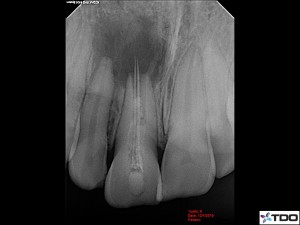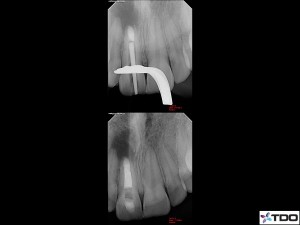It’s not a fair question to ask without giving you some additional information on the patient. I know when I look at this tooth, it begs the question of where to start.
I met this 15 year old young lady several months ago and she was in acute discomfort. The diagnosis on #9 was:
Pulpal: Previously treated
Periapical: Acute apical abscess
This tooth was treated several years earlier. There are always options to discuss after a diagnosis is made, but in this case in particular there is a lot to talk about with both the patient and her guardian.
1. The initial treatment has made nonsurgical retreatment an extremely challenging proposition
2. The patient will require antibiotic therapy and the concomittant risks
3. There is a restorative treatment plan and costs associated with it necessary after the conclusion of treatment
4. Surgical intervention may be necessary in this case
5. There will likely be a period of discomfort following initial therapy
6. The prognosis of the tooth is guarded
7. Extraction of the tooth is an option
8. A dental implant is an option
9. Sequelae of no treatment
I have mentioned this before, but a true informed consent is a lot more to me than a signature on a paper. A case like this that may involve some prolonged discomfort for the child, a questionable prognosis, prescription medications and surgical intervention requires that the patient and the guardians understand exactly what is at stake. The alternative to endodontic intervention here would likely involve extraction and the use of a removable device. A tough situation for a teenager.
Visit 1: Consultation and treatment plan. Patient placed on antibiotic
Visit 2: Access, attempted removal of filling material, drainage noted, placement of calcium hydroxide.
Visit 3: Access, and this is where it gets fun.
Despite my best efforts, the presence of a number of accessory cones with no apical stop left me unable to retrieve the obturation material orthograde. This fact, combined with persistent drainage forced me to consider a surgical approach. An Ochsenbein-Luebke incision was made and the lesion was evident upon reflection. After removing the filling material and resecting the lesion, the root was resected and retroprepped. Microscopic inspection revealed no fractures.
But wait, the root canal wasn’t done yet?
Upon determining that a surgical approach was needed, a collaplug was placed approximately 4mm short of the apex through the access. This was covered with Vitapex and then restored with flowable to prevent coronal leakage. This was then covered with Sodium perborate and a provisional restoration. The surgery was completed and the patient was dismissed.
Visit 4: The patient was seen for suture removal and reevaluation
Visit 5: The collaplug was retrieved and nonsurgical treatment was completed.
What would you have done here?



